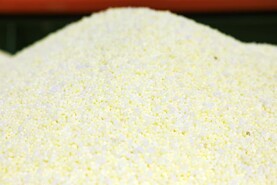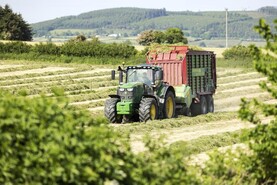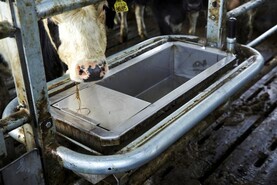Rain is causing problems for beef farmers looking to save second-cut silage, as many swards are now ready for ensiling.
The longer wet conditions delay silage, the bigger the drop in feed value of the forage. It also leaves it very late to close up for third cut if fodder reserves are still low.
Alternatively, a late second cut delays silage ground coming back in for grazing, helping to take the pressure off when grass growth tails off in late summer.
Where farmers are planning to cut silage in the week ahead, outlined are some tips to keep in mind if wet conditions continue.
1. Leave a higher residual when mowing
If ground conditions are soft when mowing second-cut grass, leave a higher residual cover than normal.
There is a risk of soil contaminating grass when harvesting in wet conditions if tyres or machinery break the surface.
Leaving a higher residual will keep grass up off the soil more, reducing the risk of contamination when mowing, raking and lifting.
2. Wilting
Unless weather takes a significant run for the better, the prospects of wilting grass for 24 hours are low.
The priority on most farms will be to use every window of opportunity to mow and lift grass on the same day.
When daytime temperatures remain in the high teens and accompanied by a good breeze, it is surprising how much grass can dry when cut in the morning and harvested in the evening.
Set the mower to spread grass as wide as possible. Grass yields in second cut will be lower than first cut, so there will be less bulk in swathes, helping to increase the rate of wilting.
Ideally, where grass will be baled, having grass as close to 30% dry matter will improve fermentation, reduce effluent and help bales from sagging when stacked.
3. Longer chop length
If grass is being ensiled in a clamp and dry matter is on the low side because of weather or lack of wilting, it is important to increase the chop length of grass.
Wet grass is more prone to slippage in the clamp, particularly when it is chopped too short. As well as being a safety hazard, silage clamps that have slipped will have greater levels of waste forage.
For grass between 25% and 30% dry matter, increase chop length to at least 10cm. Increase to at least 12cm chop length if grass has a dry matter below 25%.
4. Effluent
Take steps to catch all effluent from silage made at lower levels of dry matter. Ideally, effluent will be collected and diverted to storage tanks in cattle sheds.
This will help when mixing tanks before spreading slurry on silage aftermath and return nutrients to the soil.
5. Stacking bales
Where grass is baled at low dry matter, there is an increased risk of bales sagging and losing their shape, leading to more waste when bales are fed out.
Ideally, bales will get some chance to wilt before baling to improve fermentation and prevent sagging. The closer dry matter gets to 30% the better. Getting dry matter above 30% is a bonus.
Stacking bales in a single row is recommended if dry matter is low. Stacking bales two high will cause greater sagging and more waste fodder accumulating.
Read more
Grazing conditions variable as heavy soils become saturated
Anger at Teagasc suckler forecast
Rain is causing problems for beef farmers looking to save second-cut silage, as many swards are now ready for ensiling.
The longer wet conditions delay silage, the bigger the drop in feed value of the forage. It also leaves it very late to close up for third cut if fodder reserves are still low.
Alternatively, a late second cut delays silage ground coming back in for grazing, helping to take the pressure off when grass growth tails off in late summer.
Where farmers are planning to cut silage in the week ahead, outlined are some tips to keep in mind if wet conditions continue.
1. Leave a higher residual when mowing
If ground conditions are soft when mowing second-cut grass, leave a higher residual cover than normal.
There is a risk of soil contaminating grass when harvesting in wet conditions if tyres or machinery break the surface.
Leaving a higher residual will keep grass up off the soil more, reducing the risk of contamination when mowing, raking and lifting.
2. Wilting
Unless weather takes a significant run for the better, the prospects of wilting grass for 24 hours are low.
The priority on most farms will be to use every window of opportunity to mow and lift grass on the same day.
When daytime temperatures remain in the high teens and accompanied by a good breeze, it is surprising how much grass can dry when cut in the morning and harvested in the evening.
Set the mower to spread grass as wide as possible. Grass yields in second cut will be lower than first cut, so there will be less bulk in swathes, helping to increase the rate of wilting.
Ideally, where grass will be baled, having grass as close to 30% dry matter will improve fermentation, reduce effluent and help bales from sagging when stacked.
3. Longer chop length
If grass is being ensiled in a clamp and dry matter is on the low side because of weather or lack of wilting, it is important to increase the chop length of grass.
Wet grass is more prone to slippage in the clamp, particularly when it is chopped too short. As well as being a safety hazard, silage clamps that have slipped will have greater levels of waste forage.
For grass between 25% and 30% dry matter, increase chop length to at least 10cm. Increase to at least 12cm chop length if grass has a dry matter below 25%.
4. Effluent
Take steps to catch all effluent from silage made at lower levels of dry matter. Ideally, effluent will be collected and diverted to storage tanks in cattle sheds.
This will help when mixing tanks before spreading slurry on silage aftermath and return nutrients to the soil.
5. Stacking bales
Where grass is baled at low dry matter, there is an increased risk of bales sagging and losing their shape, leading to more waste when bales are fed out.
Ideally, bales will get some chance to wilt before baling to improve fermentation and prevent sagging. The closer dry matter gets to 30% the better. Getting dry matter above 30% is a bonus.
Stacking bales in a single row is recommended if dry matter is low. Stacking bales two high will cause greater sagging and more waste fodder accumulating.
Read more
Grazing conditions variable as heavy soils become saturated
Anger at Teagasc suckler forecast






 This is a subscriber-only article
This is a subscriber-only article










SHARING OPTIONS: